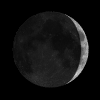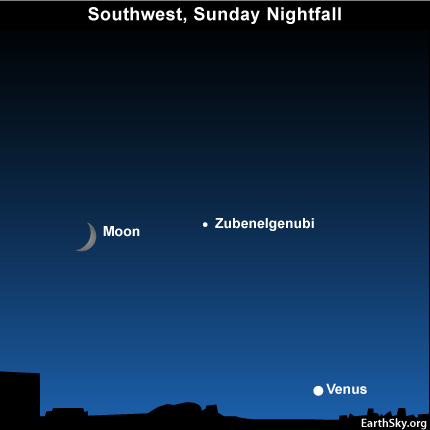Courtesy of EarthSky
A Clear Voice for Science
www.EarthSky.org

 Our chart shows the moon, the planet Venus and the star Zubenelgenubi as they appear about one hour after sunset. The sky scene, though specifically for mid-northern latitudes in North America, will look similar at mid-northern latitudes all around the world. However, European and Asian observers will see the moon somewhat closer to Zubenelgenubi, the constellation Libra’s rather faint yet visible star.
Our chart shows the moon, the planet Venus and the star Zubenelgenubi as they appear about one hour after sunset. The sky scene, though specifically for mid-northern latitudes in North America, will look similar at mid-northern latitudes all around the world. However, European and Asian observers will see the moon somewhat closer to Zubenelgenubi, the constellation Libra’s rather faint yet visible star.
Bright star in east? Might be planet Jupiter, nearly at its closest since 1951.
If you have binoculars, zoom in on Zubenelgenubi. You will see this single point of light blooming into a double star. It might be a true binary – two stars revolving around a common center of mass. If so, its orbital period could be as long as 200,000 years.
 Observers in the southern hemisphere see the moon and Zubenelgenubi over Venus – not to Venus’ upper left. Moreover, these objects set later after dark in the southern skies. Venus – the first of these bodies to set – stays out for only about one and one-quarter hours after sunset at our mid-northern latitudes.
Observers in the southern hemisphere see the moon and Zubenelgenubi over Venus – not to Venus’ upper left. Moreover, these objects set later after dark in the southern skies. Venus – the first of these bodies to set – stays out for only about one and one-quarter hours after sunset at our mid-northern latitudes.
Through the telescope, Venus now appears as a waning crescent. Yesterday, we asked if the terminator – shadow line – on Venus disk represented a Venusian sunrise or sunset. Answer: sunset.
Tonight catch the moon, Venus and Libra’s double star low in the southwest at nightfall!
Written by Bruce McClure
“False Dawn” This Week: Zodiacal Light Easier to See
Andrew Fazekas
for National Geographic News
Published September 9, 2010
Astronomy Picture of the Day from NASA/JPL
U.S. Naval Observator Astronomical Information center
The York County Astronomical Society
 Print This Post
Print This Post








